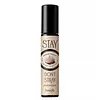What's inside
What's inside
 Key Ingredients
Key Ingredients

 Benefits
Benefits

 Concerns
Concerns

 Ingredients Side-by-side
Ingredients Side-by-side

Water
Skin ConditioningIsododecane
EmollientTalc
AbrasiveDimethicone
EmollientCetyl PEG/PPG-10/1 Dimethicone
EmulsifyingPolysilicone-11
Trimethylsiloxysilicate
EmollientGlycerin
HumectantPhenoxyethanol
PreservativeSodium Chloride
MaskingMagnesium Sulfate
Hydrogen Dimethicone
Sodium Dehydroacetate
PreservativeDisteardimonium Hectorite
StabilisingAluminum Hydroxide
EmollientBenzoic Acid
MaskingDehydroacetic Acid
PreservativeLaureth-12
EmulsifyingPropylene Carbonate
SolventEthylhexylglycerin
Skin ConditioningCI 77891
Cosmetic ColorantIron Oxides
Water, Isododecane, Talc, Dimethicone, Cetyl PEG/PPG-10/1 Dimethicone, Polysilicone-11, Trimethylsiloxysilicate, Glycerin, Phenoxyethanol, Sodium Chloride, Magnesium Sulfate, Hydrogen Dimethicone, Sodium Dehydroacetate, Disteardimonium Hectorite, Aluminum Hydroxide, Benzoic Acid, Dehydroacetic Acid, Laureth-12, Propylene Carbonate, Ethylhexylglycerin, CI 77891, Iron Oxides
Water
Skin ConditioningIsododecane
EmollientButylene Glycol
HumectantIsononyl Isononanoate
EmollientHdi/Trimethylol Hexyllactone Crosspolymer
Silica
AbrasivePolyglyceryl-4 Isostearate
EmulsifyingTalc
AbrasiveCetyl PEG/PPG-10/1 Dimethicone
EmulsifyingHexyl Laurate
EmollientSodium Chloride
MaskingMica
Cosmetic ColorantTribehenin
EmollientPEG-30 Dipolyhydroxystearate
EmulsifyingSorbitan Oleate
EmulsifyingPhenoxyethanol
PreservativeDimethicone
EmollientDisteardimonium Hectorite
StabilisingCaprylyl Glycol
EmollientEthylhexyl Palmitate
EmollientMethicone
EmollientPropylene Carbonate
SolventTetrahexyldecyl Ascorbate
AntioxidantTocopheryl Acetate
AntioxidantIsopropyl Titanium Triisostearate
EmollientSilica Dimethyl Silylate
EmollientHexylene Glycol
EmulsifyingSodium Hyaluronate
HumectantCI 19140
Cosmetic ColorantCI 42090
Cosmetic ColorantCI 77007
Cosmetic ColorantCI 77163
Cosmetic ColorantCI 77491
Cosmetic ColorantCI 77492
Cosmetic ColorantCI 77499
Cosmetic ColorantCI 77891
Cosmetic ColorantWater, Isododecane, Butylene Glycol, Isononyl Isononanoate, Hdi/Trimethylol Hexyllactone Crosspolymer, Silica, Polyglyceryl-4 Isostearate, Talc, Cetyl PEG/PPG-10/1 Dimethicone, Hexyl Laurate, Sodium Chloride, Mica, Tribehenin, PEG-30 Dipolyhydroxystearate, Sorbitan Oleate, Phenoxyethanol, Dimethicone, Disteardimonium Hectorite, Caprylyl Glycol, Ethylhexyl Palmitate, Methicone, Propylene Carbonate, Tetrahexyldecyl Ascorbate, Tocopheryl Acetate, Isopropyl Titanium Triisostearate, Silica Dimethyl Silylate, Hexylene Glycol, Sodium Hyaluronate, CI 19140, CI 42090, CI 77007, CI 77163, CI 77491, CI 77492, CI 77499, CI 77891
Ingredients Explained
These ingredients are found in both products.
Ingredients higher up in an ingredient list are typically present in a larger amount.
This ingredient is a high molecular weight silicone. It has emulsifying and skin conditioning properties.
Ci 77891 is a white pigment from Titanium dioxide. It is naturally found in minerals such as rutile and ilmenite.
It's main function is to add a white color to cosmetics. It can also be mixed with other colors to create different shades.
Ci 77891 is commonly found in sunscreens due to its ability to block UV rays.
Learn more about CI 77891Dimethicone is a type of synthetic silicone created from natural materials such as quartz.
What it does:
Dimethicone comes in different viscosities:
Depending on the viscosity, dimethicone has different properties.
Ingredients lists don't always show which type is used, so we recommend reaching out to the brand if you have questions about the viscosity.
This ingredient is unlikely to cause irritation because it does not get absorbed into skin. However, people with silicone allergies should be careful about using this ingredient.
Note: Dimethicone may contribute to pilling. This is because it is not oil or water soluble, so pilling may occur when layered with products. When mixed with heavy oils in a formula, the outcome is also quite greasy.
Learn more about DimethiconeDisteardimonium Hectorite comes from the clay mineral named hectorite. It is used to add thickness to a product.
It can also help stabilize a product by helping to disperse other ingredients.
Hectorite is a rare, white clay mineral.
Learn more about Disteardimonium HectoriteIsododecane is a fragrance, emollient, and solvent.
As an emollient, it helps your skin stay soft and hydrated. Emollients help trap moisture into your skin.
Isododecane's role as a solvent makes it a great texture enhancer. It spreads smoothly on skin and does not leave a sticky feeling behind. Isododecane also helps prevent color transfer in makeup products.
Isododecane is not absorbed into skin.
Learn more about IsododecanePhenoxyethanol is a preservative that has germicide, antimicrobial, and aromatic properties. Studies show that phenoxyethanol can prevent microbial growth. By itself, it has a scent that is similar to that of a rose.
It's often used in formulations along with Caprylyl Glycol to preserve the shelf life of products.
This ingredient is a solvent. It helps dissolve active ingredients and alter the texture of products.
Propylene Carbonate is commonly used in makeup and with clay, such as montmorillonite or bentonite.
Studies show this ingredient to be safe for cosmetics. When it is undiluted, it can cause skin irritation. (It is always diluted in skincare and makeup). This ingredient is water-soluble.
Propylene Carbonate is created from propylene glycol and carbonic acid.
Learn more about Propylene CarbonateChances are, you eat sodium chloride every day. Sodium Chloride is also known as table salt.
This ingredient has many purposes in skincare: thickener, emulsifier, and exfoliator.
You'll most likely find this ingredient in cleansers where it is used to create a gel-like texture. As an emulsifier, it also prevents ingredients from separating.
There is much debate on whether this ingredient is comedogenic. The short answer - comedogenic ratings don't tell the whole story. Learn more about comegodenic ratings here.
The concensus about this ingredient causing acne seems to be divided. Research is needed to understand if this ingredient does cause acne.
Scrubs may use salt as the primary exfoliating ingredient.
Learn more about Sodium ChlorideTalc is a clay mineral. It helps absorb moisture and improve the texture of products. Like other types of clay, Talc can have a slight exfoliating effect on skin. Talc can be added to increase the volume of products.
Some Baby powders are made by combining talc with corn starch. The word "talc" comes from Latin and originates from Arabic. Talc is a mineral commonly found throughout the world.
If you have any concerns about using talc, we recommend checking out the FDA's official page.
Learn more about TalcWater. It's the most common cosmetic ingredient of all. You'll usually see it at the top of ingredient lists, meaning that it makes up the largest part of the product.
So why is it so popular? Water most often acts as a solvent - this means that it helps dissolve other ingredients into the formulation.
You'll also recognize water as that liquid we all need to stay alive. If you see this, drink a glass of water. Stay hydrated!
Learn more about Water